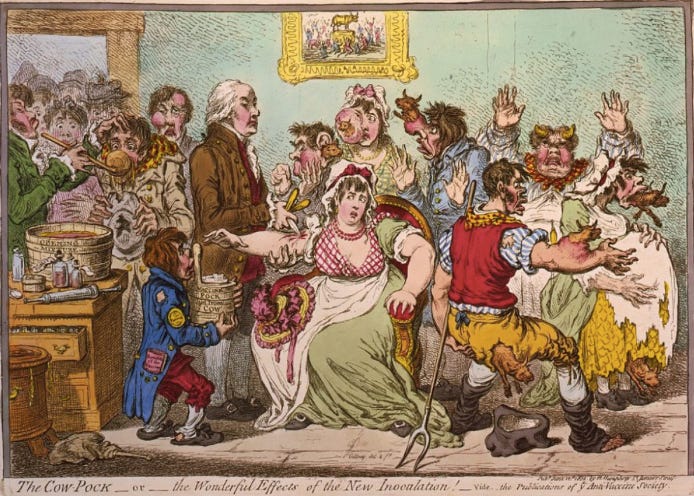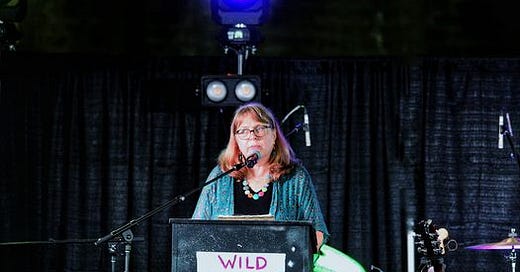

Discover more from The Cottage
A Slave, a Minister, and a Renegade Doctor
How an unlikely threesome tackled smallpox and changed American history
February 23, 1758 is an infamous date in American history. On that day, 263 years ago, Jonathan Edwards, Puritan minister and new president of Princeton, had his family inoculated against smallpox. A month later, the family recovered from the mild infection brought on by the inoculation (including Edwards’s young grandson, future vice-president Aaron Burr). But Edwards had contracted a more serious case and died on March 22. Thus ended the life and career of America’s most famous theologian.
Although the story of Jonathan Edwards and inoculation ended tragically, it is part of a much longer and important story about religion and epidemics — one that sheds some light on what we’re facing now with the COVID pandemic and the new vaccines.
*****
In 1721, when Edwards was a young man, a smallpox epidemic broke out in Boston, the type of outbreak that happened every dozen years or so. New England clergy were, contra contemporary stereotypes, fascinated by science and medicine. The most powerful clergyman in Puritan New England was Cotton Mather, pastor of Boston’s North Church. And Mather passionately believed in the God and science, so much so he was elected into the Royal Society of London.
Mather had buried two wives and eleven of his 15 children, and lived through several waves of both measles and smallpox. When the new epidemic arrived, Mather feared for his last living children. In June 1721, he wrote an address suggesting that Bostonians embrace the “wonderful practice” of inoculating people against smallpox by introducing them to a milder, controlled case of the disease than they might contract through natural means of exposure.
In April 1721, the English conducted their first inoculations. But Mather had been intrigued by the possibility of inoculation long before that first English experiment. Indeed, inoculation had been practiced for several centuries in parts of Asia and Africa. Mather heard of this from his slave (later freedman) Onesimus. In the letter, Mather claimed that God has given the Africans an “infallible preservative,” which Onesimus had described as taking the “juice of the small pox” and introducing it into cut skin of a healthy patient. The inoculated person became, in Onesimus’ words, “a little sicky,” and “no body die of it; and no body have small pox anymore.”1
The conversation between Onesimus and Mather may have happened around 1716 — and Mather looked into the idea, including interviewing other Black people in Massachusetts and tracking accounts of inoculation in Turkey and North Africa. By 1721, at the beginning of the Boston outbreak, Mather was certain that inoculation could stop the epidemic and worked to convince physicians, clergy, and the public of the same.
Mather persuaded a single doctor — Dr. Zabdiel Boylston — of the credibility of the African practice, and the doctor proceeded with inoculating a slave and Boylston’s own son successfully.
Word of Mather and Boylston’s inoculation leaked out. And the citizens of Boston were not convinced. They were terrified and feared that the inoculation would actually spread the disease and induce horrifying side effects. The city divided into pro- and anti-inoculation factions.
Almost all the clergy were for inoculation, and almost all the doctors were against. Ministers proclaimed that inoculation was God’s design to show love for all people; critics called the clergy quacks and insisted that smallpox was the will of God to humble New England. Newspapers ran sensational stories of inoculation horrors; pamphlets extolled the miracle of inoculating loved ones and neighbors. Rumors spread; some suggested inoculation was a ministerial conspiracy to increase elitist clerical power. The media was aflame with controversy, with the newsprint warfare lasting for a year.
Mather, no stranger to criticism, was shocked by the level of anger and threatening mobs. In his diary, he vented about “false Reports, and blasphemous Speeches, and murderous Wishes” directed against him, Boylston, and their families.2 Although Mather’s opponents seemed to think the African practice was “heathen,” he believed that the anti-inoculators were influenced by Satan! He accused them of having been taken over by demons to impede scientific knowledge (which Mather thought was a gift of God). He bemoaned that Boston — and particularly Boston’s physicians — had been possessed by the “power of Darkness” and a “Satanic Fury.” He couldn’t believe that people would willingly reject a practice to save their own lives and that of their neighbors.
Mather and Boylston persisted. They inoculated anyone and everyone who would take the chance on the procedure. And they kept records of the resulting (mostly mild) illnesses and the occasional deaths.
The pressure on the innovators grew. And then, on November 14, 1721, an angry anti-inoculator threw a bomb through Cotton Mather’s window. The device’s fuse fell out when it landed in the room, so it failed to go off. Wrapped around the unexploded grenade was a note: “Cotton Mather, you dog, dam you: I’ll inoculate you with this; with a Pox to you.’’
The assassination attempt on Mather made the authorities step up and try to control further violence. But a sizable number of citizens cheered — and promised that the next bomb would do its job. A fellow minister lamented that the pro-inoculation clergy were as “likely to be murdered by an abominable People, that will not let him save his Life.”3
And so both the controversy and the epidemic raged throughout the winter. When it finally waned the following year, 6,000 people — more than half of Boston’s population (11,000 in 1721) — had contracted the disease and 850 had died. Over the year, Mather and Boylston had inoculated 287 people, only 2% of whom died. Of those who contracted smallpox naturally, nearly 15% died.
Of these events, one Harvard study reports:
Mather and Boylston’s advocacy and observations resulted in what was actually one of the earliest clinical trials on record, and the use of both experimental and control groups to demonstrate the effectiveness of inoculation significantly aided the adoption of the practice.
The short version of the story is simple:
Inoculation was introduced to America by an enslaved man named Onesimus who convinced Cotton Mather, Boston’s most prominent clergyman, that is was possible to contain infectious disease. Mather, in turn, convinced one doctor and enlisted nearly all of New England’s clergy in the cause. And, in a surprising turn, Boston’s doctors resisted the new science, and aided by an anti-religious media, they fueled America’s first “anti-vaxxer” crusade.
Thus, a few decades later, Jonathan Edwards willingly inoculated his family. Because, following the lead of Cotton Mather, that’s what clergy did. They trusted the science. Sadly, in Edwards’ case, the great theologian wound up in the small minority of those who did not recover from inoculation.
*****
I love this story — mostly because it turns all our assumptions upside down. If you have ever been saved by a vaccine, it is because of this history. Without Onesimus, the entire course of inoculation and vaccine development would be different. Without Cotton Mather and courageous clergy, who believed that inoculations were God’s will and a moral requirement to love of neighbor, medical history wouldn’t be what it is. And without one doctor willing to break ranks with his colleagues, millions more may have died from smallpox.
And of course, I can’t help but think of now as the new COVID vaccine rolls out. I wish that communities of color — historically skeptical of vaccination — knew the story of Onesimus who changed American history. And I wish that religion wouldn’t be used as an excuse to avoid vaccines or foster anti-vaccine conspiracies — and that all faith communities could recover the moral vision of saving others through promising medical practices. History reminds us that things can be different — because the past isn’t what we thought.
INSPIRATION
I have been praying for this day and now it is here!
With great excitement, a touch of trepidation
And with deep gratitude
I give thanks
To all the scientists who toiled day and night
So that I might receive this tiny vaccination
That will protect me and all souls around this world.
With the pandemic still raging
I am blessed to do my part to defeat it.
Let this be the beginning of a new day,
A new time of hope, of joy, of freedom
And most of all, of health.
I thank You, God, for blessing me with life
For sustaining my life
And for enabling me to reach this awe-filled moment.
Amen
—Rabbi Naomi Levy
Almighty God we raise our hearts to you in praise and thanksgiving.
We thank you for the gift of medical knowledge, medical personnel, biotech companies and all governmental agencies who are working together to combat the coronavirus.
We thank you for the vaccines. We pray the vaccines will be made available to all. We pray for those who are sick, for those who grieve the loss of loved ones and for those whose physical, mental and economic well-being have been severely impacted by the pandemic.
Hear our prayer, oh God, in the name of Jesus , ground of our hope and strength. Amen.
—Rev. Dr. P.E. Henderson Jr.
Kenneth Silverman, The Life and Times of Cotton Mather (1985), p. 339
Silverman, p. 345
Silverman, p. 351












Fascinating. Diana went to theological seminary near Boston? I am a scientist who worked at the Massachusetts Institute of Technology in Cambridge and then onto one of the first biotech companies in Boston and marketed one of the first biotech pharmaceuticals. As I read down to the bottom prayers it was the first time I have encountered a biotech company in a prayer. From working in a biotech company back in the day, methods were cruder and less refined and more primitively clumsy than the advanced technology today. There was a lot of sweat, long hours, many failures and probably some praying going on with also some cursing going on and taking the Lord’s name in vain to be sure.
Nice story but the inoculation of that time does not compare to the horrific contents of the modern day vaccines. The C-19 vaccine of today is not even a vaccine by definition.